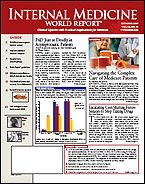Publication
Article
Internal Medicine World Report
The Insidious Course of Hand Osteoarthritis
Author(s):
Treat the Pain & Functional Limitation
Treat the Pain & Functional Limitation
By Jill Stein
VIENNA, Austria—New clinical data presented at the European League Against Rheumatism annual meeting demonstrate the aggressive nature of hand osteoarthritis.
The Genetics, Arthrosis and Progression study has shown that the clinical and radiologic status of patients with hand osteoarthritis worsens dramatically over a 2-year period.
"What's regrettable is that despite the prevalence of hand osteoarthritis and related pain and disability, little is known about how the condition progresses," said lead investigator Margreet Kloppenburg, MD, a staff rheumatologist at Leiden University Medical Center, Leiden, the Netherlands. She added, "Worse yet, there are no therapies that effectively thwart disease progression."
The trial participants were middle-aged adults (mean age, 59.7 years) who met the American College of Rheumatology criteria for clinical hand osteoarthritis or who had structural abnormalities in the hand, such as multiple bony swellings or radiologic osteoarthritis. Since patients were not selected for enrollment on the basis of osteoarthritis duration, the study included individuals with early, moderate, and advanced disease.
Pain intensity with lateral pressure was assessed in the distal interphalangeal, interphalangeal, proximal interphalangeal, and carpometacarpal 1 joints using a 4-point scale. Self-reported hand pain and functional limitations were assessed using the pain and function subscales of the Australian/ Canadian Osteoarthritis Hand Index (AUSCAN).
Standardized radiographs of the patients' hands were obtained at the start of the trial and again after 2 years. Standardized response mean (SRM) estimates were calculated.
Results in 172 of the 189 participants showed statistically significant increases in pain intensity on lateral pressure (SRM 0.67), AUSCAN pain scores (SRM 0.25), and AUSCAN function scores (SRM 0.23). In addition, in 20% of the patients, disease progression was documented by radiographic evidence, including joint-space narrowing and osteophytes.
Osteophyte progression was more likely in women and in middle-aged patients, and particularly in women at the early postmenopausal stage. The reason for the accelerated disease progression in this population is not yet known, Dr Kloppenburg said.
"The message here is that hand osteoarthritis is a serious problem," Dr Kloppenburg noted. "Doctors tend to ignore it, because existing treatments aren't effective, and because they mistakenly think that disease progression is slow," she said.
These results, she added, should serve as a wake-up call to physicians to be more aggressive about treating the pain and functional limitations associated with hand osteoarthritis.
Approximately 75% of women in their 60s have hand osteoarthritis. The findings are also a wake-up call to investigators to find treatments that can halt the rapid disease progression.





